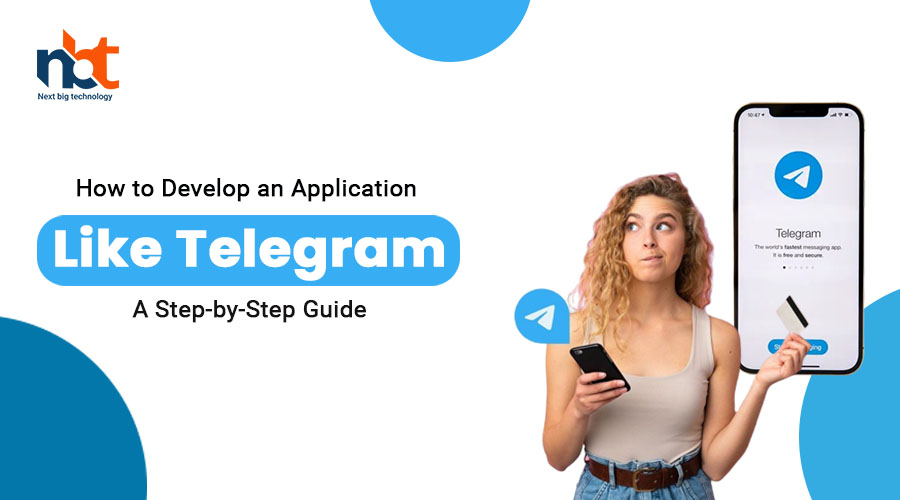Title: How to Develop an Application Like Telegram: A Step-by-Step Guide
Introduction:
Telegram has emerged as one of the leading instant messaging apps, known for its secure and feature-rich communication platform. If you’re inspired by the success of Telegram and considering building a similar application, it’s important to understand the key features, technologies, and development process involved. In this comprehensive guide, we will explore the steps and considerations required to develop an application like Telegram. Let’s dive in!
I. Understanding Telegram: Key Features and Functionality
- Instant Messaging:
- Telegram offers real-time messaging functionality, allowing users to send text, voice, and multimedia messages to individuals or groups.
- End-to-End Encryption:
- Security is a key feature of Telegram, ensuring that messages are encrypted and can only be accessed by intended recipients.
- Channels and Groups:
- Telegram enables users to create and join channels and groups, fostering community engagement and seamless content sharing.
- Media Sharing:
- Users can share photos, videos, documents, and other files of various formats within the app.
- Voice and Video Calls:
- Telegram allows users to make voice and video calls, providing a convenient and secure communication experience.
- Voice Messages:
- Users can record and send voice messages, facilitating quick and efficient communication.
- Stickers and Emojis:
- Telegram offers a vast collection of stickers and emojis, allowing users to express themselves creatively.
- Bot Integration:
- Telegram supports bot integration, enabling automated services, such as news updates, weather forecasts, or chatbots.
- Privacy Settings:
- Users can customize their privacy settings, including the ability to hide their online status, control who can add them to groups, and more.
- Multi-Platform Support:
- Telegram is available on various platforms, including iOS, Android, Windows, macOS, and web, ensuring cross-device compatibility and accessibility.
II. Steps to Develop an Application Like Telegram:
- Define the Scope and Target Audience:
- Determine the specific features and functionalities you want to offer in your application. Understand your target audience and their communication needs.
- Conduct Market Research:
- Study existing instant messaging apps, including Telegram, to identify unique selling points and areas for differentiation.
- Technology Stack:
- Choose the appropriate technology stack based on your development preferences and expertise. Consider programming languages like Swift (for iOS), Java or Kotlin (for Android), and frameworks like Node.js or PHP for backend development.
- Database and Backend Development:
- Set up a database to store user data, messages, and other app-related information. Develop the backend infrastructure to handle user management, message delivery, and other core functionalities.
- User Interface (UI) and User Experience (UX) Design:
- Design a visually appealing and user-friendly interface that aligns with your target audience’s preferences. Focus on intuitive navigation and seamless user experience.
- Real-Time Messaging:
- Implement a messaging system that enables real-time message delivery, end-to-end encryption, and synchronization across devices.
- Media Sharing and Storage:
- Develop features that allow users to share and store various media types, such as photos, videos, and documents, while ensuring efficient storage and retrieval.
- Voice and Video Calling:
- Integrate voice and video calling functionality using appropriate protocols and codecs to facilitate secure and high-quality communication.
- Push Notifications:
- Implement push notification services to notify users of new messages, calls, or other relevant app updates.
- Bot Integration:
- Develop a bot integration framework to enable automated services and interactive experiences within the app.
- Security and Privacy:
- Implement robust security measures, including end-to-end encryption, secure user authentication, and data protection, to ensure user privacy and data security.
- Testing and Quality Assurance:
- Conduct rigorous testing to ensure the app functions smoothly, handles various scenarios, and delivers a seamless user experience. Address any bugs or issues identified during testing.
- Deployment and Release:
- Prepare your app for deployment by generating necessary certificates and provisioning profiles. Publish your app on relevant app stores (e.g., App Store, Google Play Store).
- User Feedback and Iteration:
- Actively seek user feedback, monitor app performance, and release updates with bug fixes and new features to continuously enhance the user experience.
III. Cost Considerations:
- Development Team:
- The size and expertise of your development team will significantly impact development costs. Consider hiring experienced developers, UI/UX designers, and quality assurance specialists.
- App Design and UI/UX:
- Investing in a visually appealing and user-friendly design is crucial for an instant messaging app. Budget for design-related costs, including UI/UX design, graphic assets, and animations.
- Development Approach:
- Native app development typically requires more time and resources compared to cross-platform development. Evaluate the pros and cons of each approach based on your budget and timeline.
- Backend Infrastructure:
- Building a scalable and reliable backend infrastructure may require investment in cloud services, server hosting, database management, and data storage solutions.
- Security and Privacy:
- Implementing robust security measures and ensuring compliance with data privacy regulations may require additional investments in encryption technologies and security audits.
- Third-Party Services:
- Consider costs associated with integrating third-party services, such as push notification services, cloud storage providers, or analytics platforms.
- Testing and Quality Assurance:
- Allocate resources and budget for comprehensive testing to ensure your app functions flawlessly and delivers a high-quality user experience.
Conclusion:
Developing an application like Telegram requires careful planning, attention to user needs, and the right technical implementation. By understanding the key features, following the steps outlined in this guide, and considering cost factors, you can lay a solid foundation for building a successful instant messaging app. Prioritize user experience, invest in design and development expertise, and iteratively improve your app based on user feedback. With dedication and a focus on delivering a secure and seamless communication experience, your app has the potential to become a trusted platform just like Telegram.

















